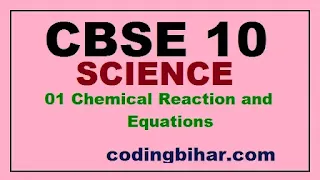Chemical Reactions and Equations
Syllabus
Chemical equation, Balanced chemical equations, Unbalanced chemical equations, types of chemical reactions: combination, decomposition, displacement, double displacement, precipitation, endothermic and exothermic reactions, neutralization, oxidation, and reduction.
Chemical Reaction - During chemical reactions, the chemical composition of substances changes or new substances are formed.
Chemical Equation - Chemical reactions can be written in chemical equation form which should always be balanced.
Reactants - The substances that undergo chemical change in the reaction, magnesium and oxygen, are the reactants.
Products - The new substance, magnesium oxide, formed during the reaction, is the product.
(Reactants)
Balanced Chemical Equation - If the number of atoms of each element in reactants is equal to the number of atoms of each element present in the product, then the chemical equation is called balanced Chemical Equation.
Example -
Unbalanced Chemical Equation - If the number of atoms of each element in reactants is not equal to the number of atoms of each element present in the product, then the chemical equation is called Unbalanced Chemical Equation.
Example -
Types of Chemical Reactions:
1. Combination Reaction - When two or more than two substances (reactants) combine chemically and form a new single substance (product) is called combination reaction.
2. Decomposition Reaction - When a substance (reactant) breaks down and form two or more than two new substances (products) is called decomposition reaction.
Note - When a decomposition reaction is carried out by heating, it is called thermal decomposition.
3. Displacement Reaction - The chemical reactions in which a more reactive element displaces a less reactive element from a compound is known as Displacement Reactions.
Note - Displacement reactions are also known as Substitution Reaction or Single Displacement reactions.
4. Double Displacement Reaction - The chemical reactions in which ions are exchanged between two reactants forming new compounds are called Double Displacement Reactions.
5. Precipitation Reaction - The reaction in which precipitate is formed by the mixing of the aqueous solution of two salts is called Precipitation Reaction.
6. Neutralization Reaction - The reaction in which an acid reacts with a base to form salt and water by an exchange of ions is called Neutralization Reaction.
7. Oxidation - Addition of oxygen or removal of hydrogen a compound is known as Oxidation.
8. Reduction - Addition of hydrogen or removal of oxygen from a compound is called Reduction.
9. Redox reaction - The reaction in which oxidation and reduction both take place simultaneously is called Redox reaction.
The rusting of iron is a redox reaction.
When copper oxide is heated with hydrogen, then copper metal and hydrogen oxide are formed.
In this reaction
and
Oxidizing agent -
The substance which gives oxygen for oxidation is called an Oxidizing agent.
The substance which removes hydrogen is also called an Oxidizing agent.
Reducing agent -
The substance which gives hydrogen for reduction is called a Reducing agent.
The substance which removes oxygen is also called a Reducing agent.
Note - The substance which gets oxidised is the reducing agent.
The substance which gets reduced is the oxidizing agent.
10. Exothermic Reaction - chemical reaction in which heat is released along with the formation of products is called exothermic chemical reactions.
Example - Burning of natural gas
Respiration in which energy is released.
11. Endothermic Reaction - A chemical reaction in which energy is absorbed is known as endothermic reactions. Most of the decomposition reactions are endothermic because decomposition reactions require energy either in the form of heat, light or electricity for breaking down the reactants
Example -
Decomposition of calcium carbonate.
Effects of Oxidation Reactions in Everyday life -
Corrosion and Rancidity.
Corrosion - The process of slow conversion of metals into their undesirable compounds due to their reaction with oxygen, water, acids, gases etc. present in the atmosphere is called Corrosion.
Example - Rusting of iron
Rusting of Iron - Iron when reacts with oxygen and moisture forms red substance which is called Rust.
Methods to Prevent Rusting -
By painting.
By greasing and oiling.
By galvanisation.
Corrosion of Copper - Copper objects lose their lustre and shine after some time because the surface of these objects acquires a green coating of basic copper carbonate,
Corrosion of Silver Metal - The surface of silver metal gets tarnished (becomes dull) on exposure to air, due to the formation of a coating of black silver sulphide
Rancidity - The taste and odour of food materials containing fat and oil changes when they are left exposed to air for a long time. This is called Rancidity. It is caused due to the oxidation of fat and oil present in food materials.
Methods to prevent rancidity-
By adding anti-oxidant
Vacuum packing
Replacing air by nitrogen
Refrigeration of foodstuff
**************************Finish*************************

